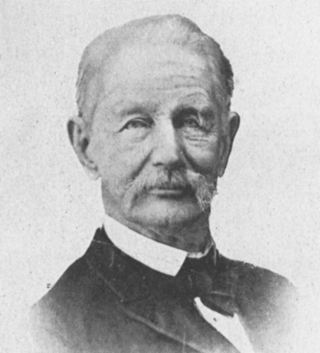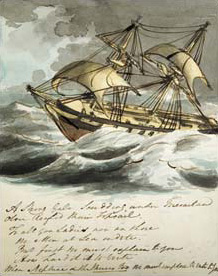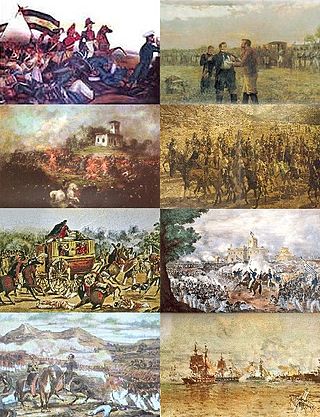
Sir Woodbine Parish KCH (14 September 1796, London – 16 August 1882, St. Leonards, Sussex) was a British diplomat, traveller and scientist.

Sir Woodbine Parish KCH (14 September 1796, London – 16 August 1882, St. Leonards, Sussex) was a British diplomat, traveller and scientist.
The son of Woodbine Parish, of Bawburgh Old Hall, Norfolk, a major in the Light Horse Volunteers, and educated at Eton College, he took up his first diplomatic post in 1814, becoming involved in events immediately following the defeat of Napoleon at Waterloo. In 1815 he went with the expedition that restored the Kingdom of Naples to the House of Bourbon after the defeat of Joachim Murat, then returned to Paris as a secretary with Lord Castlereagh's embassy that drafted the 1815 Treaty of Paris.
He was commissioned as Consul General at Buenos Aires on 10 October 1823 and then promoted to Chargé d'affaires on 24 May 1825 on a salary of £1500. [1] He served in Buenos Aires until 1832. In this capacity, he signed the Treaty of Friendship, Commerce, and Navigation with Argentina on 2 February 1825, accompanying also official recognition by Great Britain of Argentine independence.
With Joseph Barclay Pentland, Parish surveyed a large part of the Bolivian Andes between 1826 and 1827.
He served as Chief Commissioner at Naples from 1840 to 1845.
Parish combined his diplomatic work with scientific research, particularly geology and palaeontology. In 1839 he published Buenos Ayres and the Provinces of the Rio de la Plata, an account of the geology of the Buenos Aires and Río de la Plata region and his findings of mammalian fossils, presenting Megatherium bones which were assembled and exhibited in the Natural History Museum, London. He was a fellow of the Royal Society, Geological Society and Royal Geographical Society, serving as vice-president of the latter. He corresponded with Charles Darwin. [2]
He lived at Quarry House, St Leonards-on-Sea, Sussex.
Parish married firstly, in 1819, Amelia, the only child of Leonard Becher Morse, and had issue five sons and three daughters; and secondly, in 1844, Louisa Ann, daughter of John Hubbard, of Stratfield Grove, Essex, and sister of the 1st Baron Addington, having issue two sons and a daughter. Among his children were the antiquarian William Douglas Parish, and Blanche Marion Parish, wife of the first Baron Shuttleworth. [3]

The Argentine Confederation was the last predecessor state of modern Argentina; its name is still one of the official names of the country according to the Argentine Constitution, Article 35. It was the name of the country from 1831 to 1852, when the provinces were organized as a confederation without a head of state. The governor of Buenos Aires Province managed foreign relations during this time. Under his rule, the Argentine Confederation resisted attacks by Brazil, Bolivia, Uruguay, France and the United Kingdom, as well as other Argentine factions during the Argentine Civil Wars.

Carlos María de Alvear, was an Argentine soldier and statesman, Supreme Director of the United Provinces of the Río de la Plata in 1815.

Juan Martín de Pueyrredón y O'Dogan was an Argentine general and politician of the early 19th century. He was appointed Supreme Director of the United Provinces of the Río de la Plata after the Argentine Declaration of Independence.

The Viceroyalty of the Río de la Plata meaning "River of the Silver", also called "Viceroyalty of the River Plate" in some scholarly writings, in southern South America, was the last to be organized and also the shortest-lived of the Viceroyalties of the Spanish Empire in the Americas. The name "Provincias del Río de la Plata" was formally adopted in 1810 during the Cortes of Cádiz to designate the Viceroyalty of the Río de la Plata.

Karl Hermann Konrad Burmeister was a German Argentine zoologist, entomologist, herpetologist, botanist, and coleopterologist. He served as a professor at the University of Halle, headed the museum there and published the Handbuch der Entomologie (1832–1855) before moving to Argentina where he worked until his death.

In December 1832, two naval vessels were sent by the United Kingdom to re-assert British sovereignty over the Falkland Islands, after the United Provinces of the Rio de la Plata ignored British diplomatic protests over the appointment of Luis Vernet as governor of the Falkland Islands and a dispute over fishing rights.

Luis Vernet was a merchant from Hamburg of Huguenot descent. Vernet established a settlement on East Falkland in 1828, after first seeking approval from both the British and Argentine authorities. As such, Vernet is a controversial figure in the history of the Falkland Islands sovereignty dispute.

The United Provinces of the Río de la Plata, earlier known as the United Provinces of South America, was a name adopted in 1816 by the Congress of Tucumán for the region of South America that declared independence in 1816, with the Sovereign Congress taking place in 1813, during the Argentine War of Independence (1810–1818) that began with the May Revolution in 1810. It originally comprised rebellious territories of the former Spanish Viceroyalty of the Río de la Plata dependencies and had Buenos Aires as its capital.

The Cisplatine War, also known as the Argentine-Brazilian War or, in Argentine and Uruguayan historiography, as the Brazil War, the War against the Empire of Brazil, or the Liberating Crusade in Uruguay, was an armed conflict in the 1820s between the United Provinces of the Río de la Plata and the Empire of Brazil over Brazil's Cisplatina province, in the aftermath of the United Provinces' and Brazil's independence from Spain and Portugal respectively. It resulted in the independence of Cisplatina as the Oriental Republic of Uruguay.
The Supreme Director of the United Provinces of the Río de la Plata was a title given to the executive officers of the United Provinces of the Río de la Plata according to the form of government established in 1814 by the Asamblea del Año XIII. The supreme director was to wield power for a term of two years.

The Federal League, also known as the League of the Free Peoples, was an alliance of provinces in what is now Uruguay, Argentina and Brazil that aimed to establish a confederal organization for the state that was emerging from the May Revolution in the war of independence against the Spanish Empire.

Cisplatina was a Brazilian province in existence from 1821 to 1828 created by the Luso-Brazilian invasion of the Banda Oriental. From 1815 until 1822 Brazil was a constituent kingdom of the United Kingdom of Portugal, Brazil and the Algarves. After the independence of Brazil and the formation of the Empire of Brazil the Cisplatina province remained part of it. In 1828, following the Preliminary Peace Convention, the Cisplatina province became independent as Uruguay.

Manuel de Sarratea,, was an Argentine diplomat, politician and soldier. He was the son of Martín de Sarratea (1743–1813), of the richest merchant of Buenos-Aires and Tomasa Josefa de Altolaguirre. His sister Martina de Sarrateas (1772–1805) married Santiago de Liniers, vice-roy del Rio de la Plata.

Spain–Uruguay relations are the current and historical relations between Spain and Uruguay. There is community of 67,000 Spanish nationals residing in Uruguay and 33,000 Uruguayan nationals residing in Spain. Both nations are members of the Association of Spanish Language Academies, Organization of Ibero-American States and the United Nations.

The Argentine Civil Wars were a series of civil conflicts of varying intensity that took place through the territories of Argentina from 1814 to 1853. Beginning concurrently with the Argentine War of Independence (1810–1818), the conflict prevented the formation of a stable governing body until the signing of the Argentine Constitution of 1853, followed by low-frequency skirmishes that ended with the Federalization of Buenos Aires. The period saw heavy intervention from the Brazilian Empire that fought against state and provinces in multiple wars. Breakaway nations, former territories of the viceroyalty, such as the Banda Oriental, Paraguay and the Upper Peru were involved to varying degrees. Foreign powers such as the British and French empires put heavy pressure on the fledgling nations at times of international war.

The dissolution of the Viceroyalty of the Río de la Plata meant the breakup of the Spanish colony in South America and the creation of new independent countries. Most of the territory of the Spanish viceroyalty is now part of Argentina, and other regions belong to Bolivia, Brazil, Paraguay and Uruguay.
Thomas Woodbine Hinchliff was an English mountaineer, traveller, and author, from 1875 to 1877 the seventh President of the Alpine Club.
John Parish Robertson (1792–1843) was a Scottish merchant and author.
William Douglas Parish was a British clergyman, antiquarian, and author on dialects.